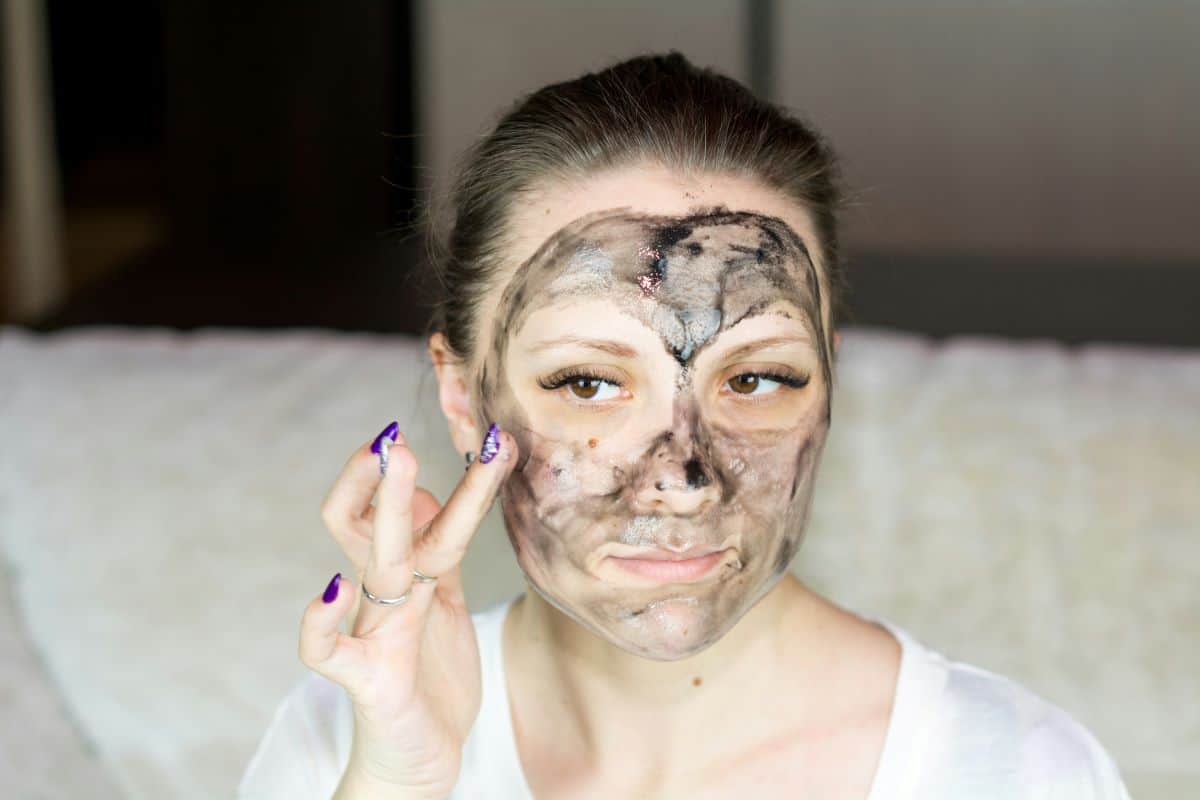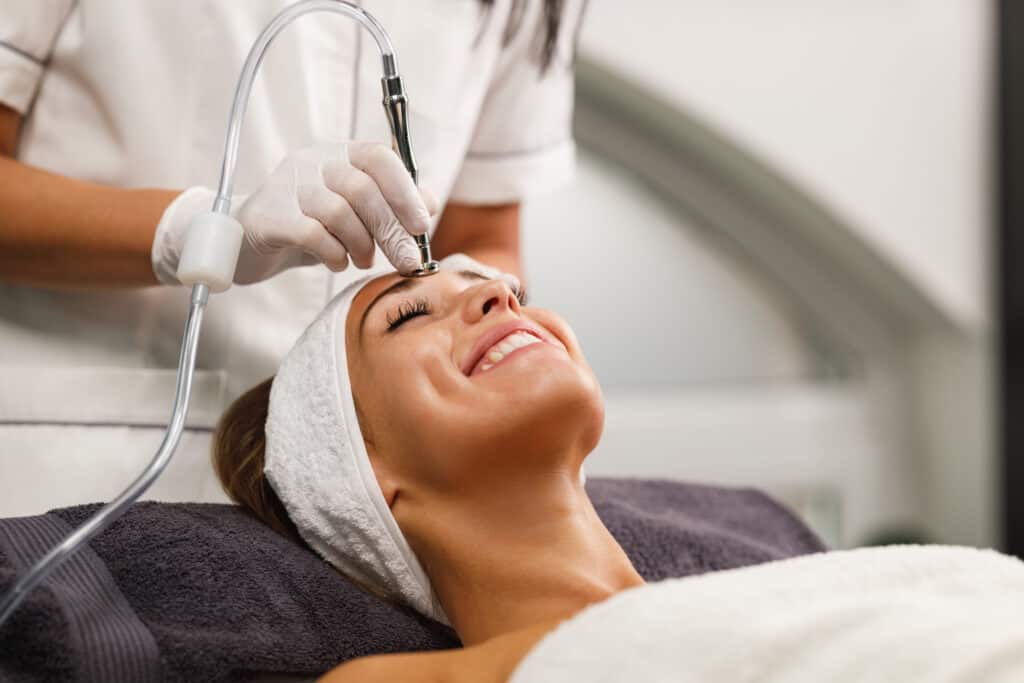
Hyperpigmentation manifests as dark spots on the skin, a condition that many find challenging to manage. It arises from various factors, such as sun damage, acne scars, and hormonal changes, leading to an uneven skin tone. Chemical peels have emerged as an effective treatment for this concern, utilising substances like glycolic acid peels, lactic acid, and TCA peels to renew the skin’s surface. These procedures, varying from light peels to deep peels, target the skin’s different layers, effectively reducing skin discolouration. They serve not just those with mild issues but also individuals grappling with more pronounced hyperpigmentation. By carefully selecting the correct type of peel, whether alpha hydroxy acid or beta hydroxy acid based, one can significantly mitigate the appearance of dark spots and achieve a more even, youthful complexion.
Types of Chemical Peels
Chemical peels have been a cornerstone in treating hyperpigmentation, dark spots, and uneven skin tone. They are categorized into light, medium, and deep peels, each targeting different layers of the skin. Light peels, such as those with alpha hydroxy acid or beta hydroxy acid, gently exfoliate the surface, making them suitable for mild discolouration and sensitive skin. Medium peels involving glycolic acid or TCA reach the middle layers to address moderate sun damage and deeper skin discolouration.
A deep peel penetrates extensively for the most severe cases, including acne scars. These procedures, often using higher concentrations of TCA, demand longer recovery time but offer the most dramatic transformations. Selection hinges on the individual’s skin type, severity of hyperpigmentation, and sought-after results. Successfully navigating these options promises a brighter, more even complexion.
Benefits of Chemical Peels for Hyperpigmentation
Chemical peels have emerged as a formidable victory in the battle against hyperpigmentation, dark spots, and sun damage. Treatments like glycolic acid peels, salicylic acid, and TCA peels delve deep to remove layers of uneven skin tone. They boast an ability to rejuvenate not just the complexion but the confidence of those who undergo them. Skin discolouration met its match with these procedures, as they efficiently fade dark spots and bring forth a uniformly luminous skin surface. Moreover, the use of chemical peels extends beyond just aesthetic improvements.
They contribute significantly to skin health by eliminating acne scars, preventing future outbreaks, and minimizing pores. This effective treatment, when chosen correctly, aligns with various skin types, including sensitive and dark skin, introducing a level of inclusivity in skincare routines. Recovery time is minimal, positioning chemical peels as an appealing option for those seeking rapid, impactful results. Indeed, the journey towards clearer skin is enriched with the promise of brighter days.
Choosing the Right Chemical Peel
Choosing the right chemical peel involves several critical factors. Firstly, assessing the severity of hyperpigmentation is crucial. For milder cases, light peels with glycolic acid or lactic acid might suffice. Yet, deeper concerns often necessitate medium or deep peels, like those with TCA, to effectively reach and treat the target areas. Secondly, understanding your skin type — particularly if you have sensitive or dark skin — plays a significant role. People with darker skin tones need to proceed with caution as deeper peels increase the risk of unwanted side effects, such as further pigmentation or scarring. Salicylic acid peels, known for their gentleness, could offer a safer option for those with sensitive skin or concerns about exacerbating discolouration. Ultimately, engaging with a skin care professional can guide you to the most effective treatment, balancing the depth of peel required against the potential risks and ensuring a successful outcome.
Glycolic Acid Peels
Glycolic acid peels have proven effective in treating hyperpigmentation. They belong to the alpha hydroxy acid (AHA) family and offer a solution to those plagued by dark spots. By penetrating the upper layers of the skin, these peels expedite cell turnover, revealing fresher, more even-toned skin underneath. They have been a go-to for individuals seeking to lighten unwanted pigmentation and achieve a radiant complexion.
Who should consider this option? People with mild to moderate hyperpigmentation stand to gain significantly. This includes those battling with uneven skin tone, sun damage, or acne scars. Yet, those with sensitive skin must proceed with caution. Glycolic acid peels, while beneficial, can provoke irritation in more delicate skin types. It’s advisable for anyone contemplating this course of action first to consult a dermatologist. Such a professional can offer personalized advice, taking into account one’s specific skin attributes and the severity of their hyperpigmentation.
Salicylic Acid Peels
I discovered salicylic acid peels as a beacon of hope for my acne-prone skin plagued by hyperpigmentation. These peels, belonging to the beta hydroxy acid family, dive deep into pores, unclogging them and removing dead skin cells. In my journey, this feature proved invaluable. Not only did it help clear my acne, but it also lightened those stubborn dark spots. Salicylic acid’s unique ability to penetrate oil-laden hair follicle openings made it incredibly effective.
However, choosing this treatment required careful consideration of my sensitive skin. I learned that while salicylic acid is milder than other chemical peels, it can still lead to dryness and peeling. To mitigate these issues, I kept my skin well-hydrated and avoided excessive sun exposure, which can worsen hyperpigmentation; for anyone considering this route, understanding your skin’s tolerance and incrementally adjusting the concentration of salicylic acid is vital. Through this approach, I achieved a significant improvement in my skin’s texture and an even complexion, marking a transformation in my skin health and boosting my confidence significantly.
TCA Peels for Deeper Concerns
TCA peels, known formally as trichloroacetic acid peels, dive into the skin’s deeper strata, tackling severe hyperpigmentation head-on. By penetrating beyond the superficial layers, they aim at the root cause of dark spots, sun damage, and uneven skin tone. People have turned to this method after light and medium peels provided insufficient results. The intensity of TCA peels makes them a formidable choice against stubborn skin discolouration.
However, their prowess comes with a caveat. Individuals should brace for a more intense recovery time, as the deeper intrusion can lead to pronounced redness and peeling. Those with sensitive or dark skin must proceed with caution. The risk of paradoxical hyperpigmentation, where the treatment ironically darkens the skin further, is an undeniable concern. Thus, a thorough consultation with a dermatologist is crucial before deciding on a TCA peel, ensuring it aligns with one’s skin type and hyperpigmentation severity.

Pre and Post-peel Care
If you’re embarking on a journey with a chemical peel, you’ve chosen an effective treatment for battling hyperpigmentation, dark spots, and uneven skin tone. Preparation is key, and it starts with discontinuing any products containing alpha hydroxy acid or beta hydroxy acid, including glycolic acid peels and salicylic acid treatments, at least a week before. This preparatory step will ensure your sensitive skin isn’t overly irritated by the peel.
After the peel, recovery time becomes a paramount concern. You should shield your skin from sun damage with a high-SPF sunscreen to prevent further skin discolouration. Hydration is crucial, both internally through drinking plenty of water and externally with gentle, non-comedogenic moisturizers. For those with dark skin or prone to acne scars, post-peel care emphasises avoiding direct sun exposure and picking at peeling skin to mitigate risks of complications.
Remember, patience during the recovery period leads to brighter days ahead. Deeper concerns like severe hyperpigmentation may require more intense TCA peels, where pre and post-treatment care are even more vital to maximize outcomes and minimize side effects. Consultation with a dermatologist beforehand can tailor this care to your unique skin needs, ensuring the journey to an even skin tone is safe and effective.
Potential Risks and Side Effects
Chemical peels have proven to be an effective treatment for hyperpigmentation, sun damage, and uneven skin tones. Troubles arise, however, when considering the sensitive nature of some skin types. Those with darker skin or a tendency toward sensitivity must tread with caution. Deep peels, particularly, pose a more significant threat. They delved into the skin with a voracity that could lead to unwanted outcomes like scarring or, ironically, more pronounced hyperpigmentation. This effect, known as paradoxical hyperpigmentation, proves more common in alpha hydroxy acid and beta hydroxy acid treatments, including glycolic acid peels, lactic acid, and TCA peels.
To lessen these side effects, a careful evaluation of one’s skin type becomes paramount. Dermatologists recommend starting with light peels for those new to the treatment or those with sensitive or dark skin. Light peels offer a gentler option, reducing the risk of exacerbating skin discolouration or causing detrimental reactions. For individuals with acne scars or severe hyperpigmentation, medium peels might be considered, but only under close professional supervision to monitor the skin’s response and adjust treatment accordingly.
Pre- and post-peel care hold the key to minimising these risks. Before undertaking a peel, it is crucial to prepare the skin, which might involve using specific skin care products as directed by a dermatologist. Following the treatment, protecting the skin from sun damage becomes essential; hence, a high-SPF sunscreen should be applied daily. With careful attention to these precautions, individuals can ensure their journey toward reducing dark spots and achieving a more even skin tone proceeds with the least possible risk.
Alternatives to Chemical Peels
In exploring options for managing hyperpigmentation, dark spots, uneven skin tone, and sun damage beyond chemical peels, two effective treatment avenues surface. Laser therapy and topical treatments stand out as viable alternatives. Laser therapy, a technology-driven option, addresses dark skin discolouration with precision. This method can yield significant improvements for those concerned about recovery time, as it typically promises a swifter healing process than deep peels. Meanwhile, topical treatments offer a gentler route. Formulations containing active ingredients like alpha hydroxy acid, beta hydroxy acid, and tretinoin have been proven to treat hyperpigmentation and acne scars effectively. For individuals with sensitive skin or those seeking a less invasive solution, these alternatives could be the answer. Notably, both options underscore the importance of tailored approaches to skin care. Ultimately, a consultation with a dermatologist will guide you toward the best method for your specific situation, factoring in the severity of your skin discolouration and your overall skin health.
Brighter Days Ahead: Maximising Your Chemical Peel Outcomes
Embarking on the journey to diminish the appearance of hyperpigmentation can lead you down numerous paths. It could seem daunting, yet the pursuit of more apparent, more radiant skin holds a promise that many of us find undeniable. Chemical peels have emerged as a beacon of hope for those of us struggling with dark spots, uneven skin tone, and the remnants of sun damage. They beckon with the allure of effective treatment, but determining the best chemical peel for your unique situation demands insightful consideration.
I discovered that the choice between glycolic acid peels, salicylic acid procedures, and TCA peels hinges not only on the severity of hyperpigmentation but also on our skin’s characteristics. For instance, glycolic acid and lactic acid peels, being alpha hydroxy acids, offer a gentler approach that is suitable for minor discolourations and those of us with sensitive skin. Salicylic acid, a beta hydroxy acid, targets acne scars under the umbrella of hyperpigmentation, combating breakouts while addressing dark spots.
I learned that those with deeper concerns might lean towards TCA peels. Though potent and capable of reaching mid to deep layers of skin, they command respect for their recovery time and the heightened vigilance for post-peel care they necessitate, especially for individuals with dark skin or those prone to sensitive reactions. Speaking from experience, consulting a dermatologist was instrumental in unveiling the veil of uncertainty. Their guidance ensured that I selected not just an effective treatment but one that harmonized with my skin’s needs, marked the end of my struggle with hyperpigmentation, and ultimately fostered a renewed sense of confidence in my complexion. Let this be a beacon for you, too, as brighter days await with the proper chemical peel treatment.






